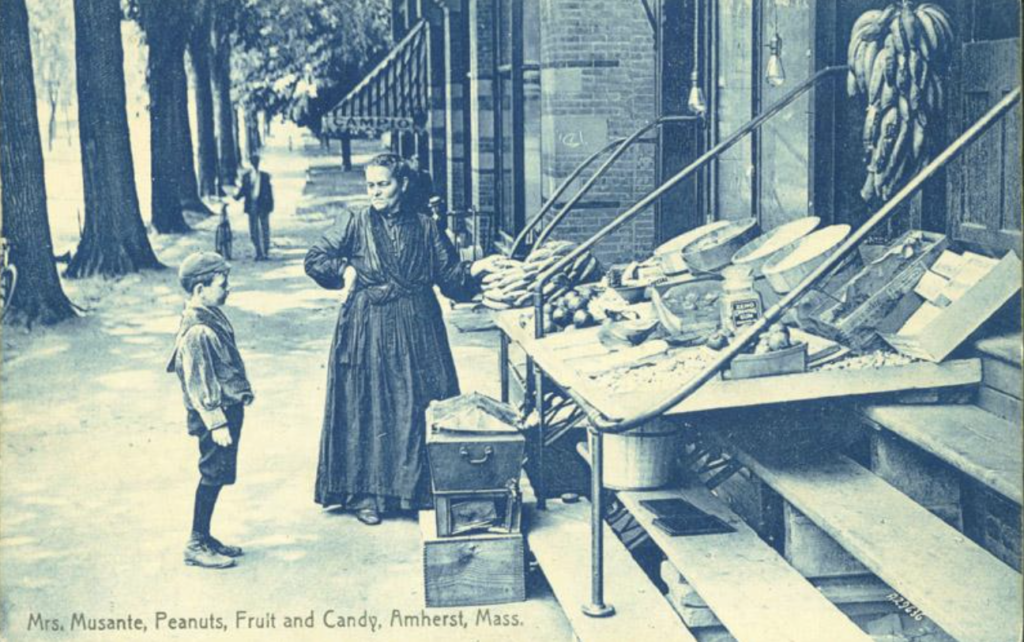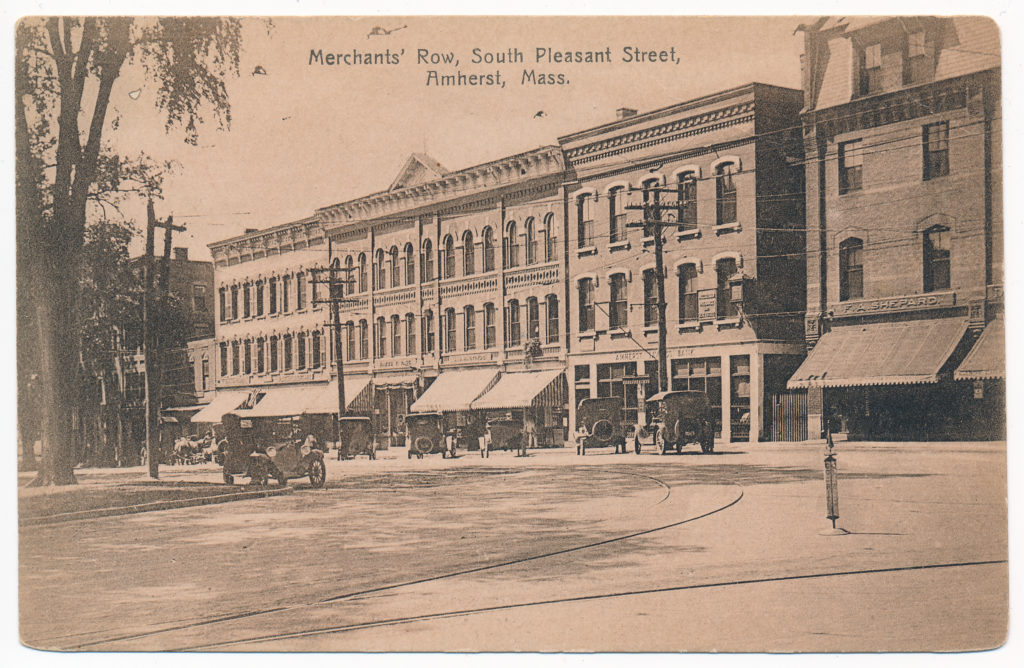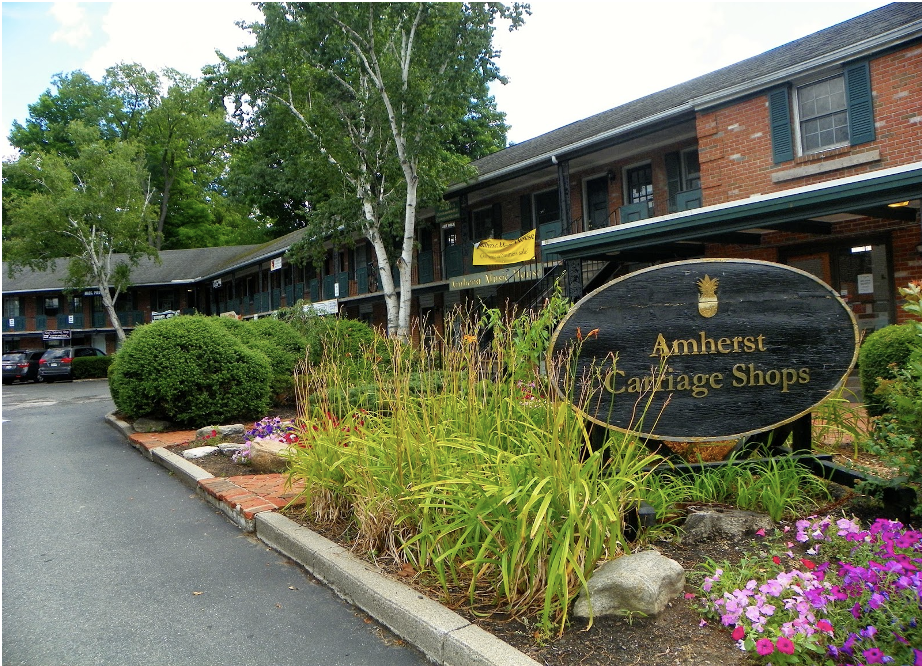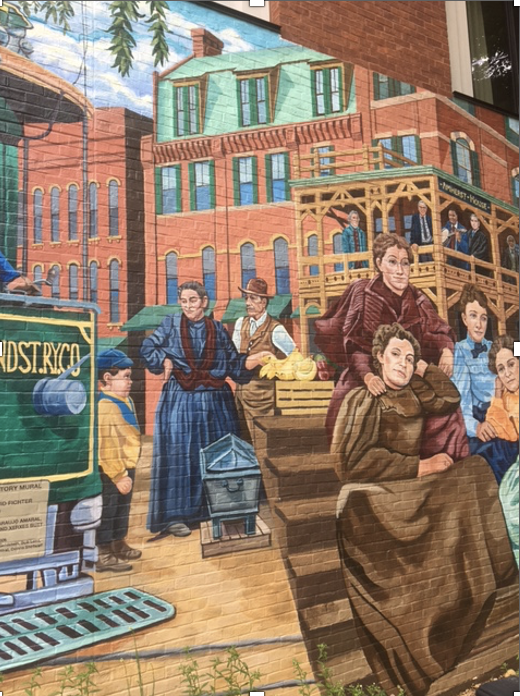Amherst History Month-by-Month: Mrs. Musante

Photo: Edgar Scott Postcard Collection: SPC187 - Mrs. Musante, Peanuts, Fruit, and Candy Courtesy of the Jones Library Special Collections, Amherst, Massachusetts.
It is places rather than spaces that are important when it comes to historic preservation. Place is specific, more meaningful, embodied even. There is now something called place-based learning, an approach that engages learners in their community, including their physical environment, local culture, history, or people. How do we recognize the historic value of places? My thought is that it is found in three elements: people, buildings, and the lay of the land.
Amherst grows and changes all the time but to really thrive, we must know how we were/are rooted, why we are where we are now. And, most importantly, how we can change for the better. I write from the perspective that Amherst’s buildings are as important as the knowledge collected into our towns’ libraries or in the stories and memories of our citizens. We want our children’s children to appreciate Amherst as much as we do now. Amherst’s physical townscape holds memories that otherwise will not be as easy to see, respect and remember if the town is altered beyond recognition.
When I first moved here I wanted to find out more about the people who had made Amherst their home. I visited the Amherst Historical Society and pored over maps and photographs. I listened to older people’s stories about the community and I went on historic tours. But I also looked at our built environment, neighborhood by neighborhood. As a public historian trained in architectural history, all this never ceases to fascinate me.
One day my eyes lit on a small postcard exhibit in the Jones Library. One of the postcards was of someone called Mrs. Musante. It is not recorded who the child is who stands beside her (a potential customer?) nor the man wheeling his bicycle in the background. But I got caught up in her possible experiences of downtown Amherst.
Musante
I had heard of an American actor called Tony Musante; I’d swam with friends at Musante Beach, by the reservoir in nearby Leeds/Northampton. I’m an immigrant to this country and can tell you that Leeds, Massachusetts is a far cry from the large industrial city in Yorkshire, England that I used to frequent as a student.
I learned there was a satellite health center from the hill towns slated for Amherst. It opened in the Bangs Community Center in 2017 and was named after a popular town official, John P. Musante. He had helped to promote the health center, and an Amherst College nieghbor, James Brassard, had sculled his way to F lorida to raise funds. A plaque in the reception area reads: “Dedicated to the Memory of John P. Musante (1961–2015) Amherst Town Manager (2010–-2015) whose commitment to the public good and passion for improving access to health care was instrumental in making this health center a reality.”
If or how he was related to Mrs. Musante isn’t clear to me and exactly who all the Musante families are today and when they first came to this country from Italy is for another person to tell. But I found out that Mrs. Musante’s first name was Candida and that her husband was known as “Peanut.” His real name was actually John but the nickname stuck.
The historic photograph above shows Candida Musante selling from a stall in front of the Merchants Row (1880) block of South Pleasant Street which itself was filled with small shops and local businesses (that now include Collective Copies, Laughing Dog Bicycles and Veracruzana.) It is a handsome Victorian brick building with a pediment in the center and fine stone trim.

The Musantes had a similar fruit and nut stall on the campus of Amherst College. They were both born in the middle of the 1800s – in 1848 (itself an auspicious year in Europe) – and were first-generation Italian-Americans in the valley, living in Northampton. They moved to Amherst in 1882. Peanut John died in 1904 and Candida continued to operate the fruit and nut stands for 20 years after that, passing away herself in 1924.
As I walk around town looking for other signs of Amherst’s historic past, I am grateful for our historic buildings and also that John and Candida Musante are remembered. Both of them were memorialized in an amazing mural, the one that used to grace the back of the Amherst Carriage Shops. As I have learned, Amherst is home to many great public art murals.
Not to digress too much, but I have a vague memory of the Carriage Shops and the first version of the mural. As Scott Merzbach tells it: “The original mural, which [David] Fichter undertook in 2004 and 2005, was commissioned by the Amherst Historical Commission to bring attention to the historic West Cemetery, following the success of placing the cemetery on the National Register of Historic Places.”(Daily Hampshire Gazette,:11/15/2019) I’d seen it because we had driven to Amherst a couple of decades ago to visit the Baird House (designed by Frank Lloyd Wright) and walked round Amherst Center after lunch at Judies. The Carriage Shops have gone now and while some stores have since been re-housed in our downtown, others didn’t re-emerge. And in the process of its demolition, we began to lose a little of our purchase on what is appropriate for design in a college town, especially in terms of the scale of our new buildings.

So I fast forward to the town’s commitment to recreate the mural. And the Musantes. David Fichter, who lives in Cambridge, was brought back with his team to complete the new mural. I vividly remember attending its dedication in 2019 when the Amherst Area Gospel Choir sang. Candida and John ‘Peanut’ Musante appear in this version of the mural, that also features the poet Emily Dickinson and many other people associated with Amherst from all walks of life.

Our town is changing in many ways in just the five years that I’ve lived here. The value of a perspective that is grounded in history and architecture seeks to ensure that as we go forward (especially with the COVID-19 pandemic in mind) that we don’t lose our sense of place. It is after all unique to us. It is a perspective we neglect at our peril as we shape our future together here in the valley. ~
Amherst History Month-by Month is a monthly column on historic preservation, taking a look at Amherst’s historic buildings and neighborhoods and the stories behind them. It may also, from time to time, explore the challenges of historic preservation in a town such as ours that is so rich in historic resources. Hetty’s next article will be about Hazel Avenue and the A.M.E. and Hope Churches. See previous columns here.
Hetty Startup lives and works in Amherst and is a member of the Amherst Historical Commission.

When I grew up in Amherst in the 1940’s, the Musantes owned the “Fruit Store” which was on Amity Street about 50 feet to the left of the Amherst Theater. One of the sons was a couple of years younger that I; we hung around together a bit. The building on the corner of Amity and South Pleasant Street where the Bank of America is was the “Record Store” where we bought 78 rpm records; singles and albums of classical music … and later LPs.
Mike Burke
(now living in Belchertown)
Dear Mr. Burke:
Thanks so much for adding your recollections of the Musantes as a family. I want to learn more about the Amity Street “fruit store” and about the many families that have left their mark on Amherst’s history.
I too remember 78 rpm records just barely from my childhood….and a local record shop (at Notting Hill Gate, London) that was such a draw as I began to save up to buy singles and LPs of my own. I still know people for whom a local Record Store was THE place to be from their youth wherever they grew up in New England. Here is one special place that comes to mind. https://06880danwoog.com/2013/07/11/sallys-place-to-close-a-westport-era-to-end/
One of my fellow townsfolk suggested [after the pandemic] that the roof of the Bank of America building would make a great place for a bar. Although drinking habits are changing as I write this note back to you, I still think its a special vantage point from which to look out over our town center. Oh, and Belchertown has such an interesting history! I have a short article right here in the Indy about Belchertown, too.
https://www.amherstindy.org/2024/11/08/amhersts-neighboring-towns-belchertown/